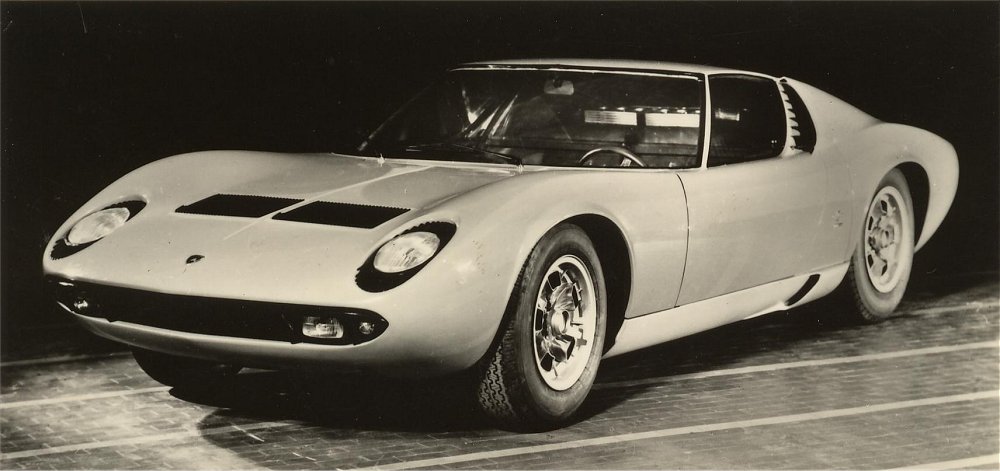Description
The Lamborghini Miura P 400 Prototype was the car that changed the course of Lamborghini’s history and, arguably, the direction of the entire sports car world. Unveiled at the 1966 Geneva Motor Show, it was the first public glimpse of what would become the Miura production car—a revolutionary mid-engined supercar that redefined automotive design, engineering, and performance. The prototype, a collaboration between Lamborghini’s brilliant young engineering team and the visionary designer Marcello Gandini of Bertone, was more than a concept; it was a statement of intent that announced Lamborghini as a true innovator and rival to the most established names in Italy.
The Miura project began in 1965 as an unofficial after-hours effort by three of Lamborghini’s brightest engineers: Gian Paolo Dallara, Paolo Stanzani, and Bob Wallace. At the time, Lamborghini’s lineup consisted of front-engined grand tourers like the 350 GT and 400 GT, elegant cars that reflected Ferruccio Lamborghini’s preference for refined high-speed touring over racing. Yet Dallara and his colleagues envisioned something entirely different—a pure sports car built around a mid-mounted engine, inspired by the architecture of contemporary Formula 1 and endurance racers. They designed a compact, lightweight chassis with the transversely mounted V12 engine positioned behind the driver, sharing its oil with the gearbox and differential in a single integrated unit to save space and weight.
When Ferruccio Lamborghini first saw the chassis, designated P 400 (for “Posteriore 4 Litri”), he was skeptical. He had little interest in racing and doubted the commercial viability of such an extreme car. However, when the bare chassis was displayed at the 1965 Turin Motor Show, it drew enormous attention from both the press and potential buyers. The interest convinced Lamborghini to allow the project to proceed, provided that it would be clothed in a body worthy of its engineering brilliance.
For the design, Lamborghini turned to Carrozzeria Bertone, where a 27-year-old Marcello Gandini was tasked with shaping the car’s exterior. The result was breathtaking. The Miura prototype was unlike anything the public had ever seen: impossibly low, wide, and elegant, with flowing lines that seemed to merge speed and sensuality into one seamless form. The long, curving bonnet, side air intakes, and fastback tail gave the car a balance and harmony that instantly captivated the world. The prototype’s front and rear sections were hinged for full access to the mechanical components, emphasizing its racing inspiration while adding to its dramatic presence.
Beneath the sculpted aluminium skin lay the 3,929 cc V12 engine designed by Giotto Bizzarrini, producing around 350 horsepower in its early configuration. Mounted transversely behind the cockpit, it drove the rear wheels through a five-speed gearbox and delivered the kind of performance that had previously been reserved for pure competition cars. The compact layout allowed the Miura to achieve near-perfect weight distribution and an extraordinarily low profile, giving it both stability and agility unmatched by any road car of its time.
The interior of the prototype was still in development when it was shown at Geneva in March 1966. The show car featured a largely unfinished cabin with simple bucket seats and a minimal dashboard, but the underlying ergonomics hinted at the driver-focused cockpit that would appear in production. The car’s proportions were so radical that even in static form, it drew crowds at the show that overwhelmed Lamborghini’s modest display. Ferruccio himself was astonished by the reaction, realizing that what had begun as an internal experiment had captured the imagination of the entire industry.
The Miura P 400 Prototype was both an engineering marvel and a design masterpiece. Its transversely mounted engine, integrated transmission layout, and monocoque-inspired chassis were groundbreaking, but it was the emotional impact of its design that truly set it apart. The car looked alive—sleek, poised, and ready to spring forward. The combination of beauty and innovation made it an instant icon.
After Geneva, the prototype underwent further refinement, evolving into the production-ready Miura P 400 later that year. The production car retained most of the prototype’s appearance but incorporated practical modifications for cooling, stability, and comfort. Only one true prototype was built, but it served as the genesis of a lineage that would define Lamborghini’s identity for decades.
When the first production Miuras reached customers in 1967, they confirmed what the prototype had promised: this was not merely a car but a revolution. It was faster, more beautiful, and more technically advanced than anything else on the road. It inspired rivals across Europe to pursue mid-engined layouts and established Lamborghini as the maker of the world’s most exotic and desirable automobiles.
Today, the Lamborghini Miura P 400 Prototype is recognized as one of the most significant concept cars ever built. It bridged the gap between the racing world and road-going performance, creating the template for the modern supercar. Its elegant lines, daring engineering, and unfiltered passion captured the spirit of a new era in automotive history.
The Miura Prototype remains a symbol of pure innovation—a car born not from a marketing plan but from the imagination and courage of a few visionary engineers and designers. It was the spark that ignited the legend of Lamborghini and forever changed what a sports car could be.
